"A Complete Guide to Understanding Identity Verification"
Identity verification has become a critical component in protecting both individuals and businesses in today’s digital landscape. From banking and e-commerce to healthcare and government services, verifying who people really are helps maintain security and reduce fraud. But how exactly does identity verification work, and why is it so crucial?
This guide
breaks down the essentials of identity verification, explaining its purpose,
key methods, and its growing importance in a world where trust is increasingly
digital.
What
Is Identity Verification?
Identity
verification is the process of confirming that a person is who they claim to
be. It ensures that individuals or entities using online or offline services
match their identities to verifiable information. Verification serves as a
security layer for businesses and institutions needing to deter impersonation
or fraudulent activities.
Why Is It Important?
The consequences
of identity-related fraud are significant. Reports show billions of dollars
lost annually due to identity scams, and the rising sophistication of
fraudsters only increases the threat. By ensuring that identities are verified,
organizations can drastically reduce theft, protect sensitive information, and
increase the trust of their customers.
Industries like
financial services, telecommunications, and online marketplaces have embraced
identity verification to not only comply with data security regulations but
also safeguard their operations and maintain customer satisfaction.
Key
Methods of Identity Verification
Identity
verification methods vary depending on industry requirements, jurisdictions,
and the level of security needed. Here are some of the most widely used
methods:
1. Document Verification
Document
verification involves matching an individual’s personal information with valid
government-issued IDs, such as passports or driver’s licenses. Advanced
technologies use artificial intelligence to detect forgery or tampering in
these IDs, making it a reliable approach.
2. Biometric Verification
Biometric data,
such as fingerprints, facial recognition, and voice analysis, take verification
a step further by using physical traits unique to a person. This method is
highly secure and increasingly adopted due to its accuracy and fraud-prevention
capabilities.
3. Two-Factor
Authentication (2FA)
Although more
commonly associated with account security, two-factor authentication is a vital
complement to other identity verification methods. It typically involves a mix
of passwords and one-time passcodes (OTPs) sent to a user’s phone or email.
4. Knowledge-Based
Authentication (KBA)
KBA asks users
security questions that the rightful account owner should know, such as the
name of their first school or their mother’s maiden name. While it adds another
verification layer, KBA can sometimes be vulnerable to social engineering
attacks.
5. Real-Time Identity
Databases
For industries
such as healthcare and banking, running real-time checks against national or
regional identity databases helps confirm an individual's legitimacy when
accessing sensitive platforms or completing transactions.
The
Role of Identity Verification in the Digital Age
With the rise of
online fraud, cybercrime, and identity theft, identity verification serves as a
foundation for safer online activities. It improves cybersecurity for
businesses and ensures compliance with global standards, such as GDPR (General
Data Protection Regulation) or KYC (Know Your Customer) requirements.
At its core,
identity verification builds trust between businesses and their customers,
helping organizations secure transactions, protect privacy, and ensure seamless
user experiences. This trust is essential in sectors like e-commerce, health
tech, fintech, and even education, where sensitive customer data is exchanged
regularly.
Final
Thoughts
Identity
verification is an integral part of today’s digitally connected world. Its
purpose extends beyond compliance; it is about building lasting relationships
with customers based on trust and security. With the right mix of technology
and policy, identity verification ensures transparency and reliability that
benefits both businesses and users.
By understanding
and adopting robust identity verification measures, businesses can move forward
with confidence, knowing they are equipped to counter fraud and foster secure,
trusted environments.

Comments
Post a Comment